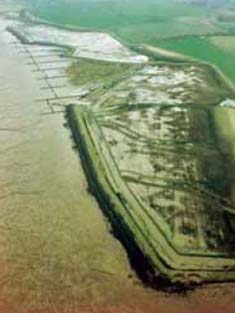Conclusion
In this course we have used the Blackwater to identify the theme of environmental response. Responses involve the interaction of human and natural processes. For example, the rise in sea level experienced in the estuary is partly natural readjustment after the Ice Age and partly a response to greenhouse gas emissions caused by human activity. This rise has brought about two forms of response: human responses to change in the environment and responses made by the environment.
The first form, responses by humans to the impacts of environmental change, includes the building of sea walls to prevent the loss of productive land, and various measures of coastal protection and conservation management to prevent further loss of saltmarsh and its biodiversity.

The second form of response, that made by the environment to changes, includes: coastal erosion as a response to sea level rise; extinction of species through loss of habitat; and loss of saltmarsh through coastal squeeze.
You may note that responses tend to have both negative and positive impacts. Thus, responses by and to the environment have resulted both in the loss of saltmarsh by flooding and embankment, and in its re-creation through managed retreat (Figure 20).
